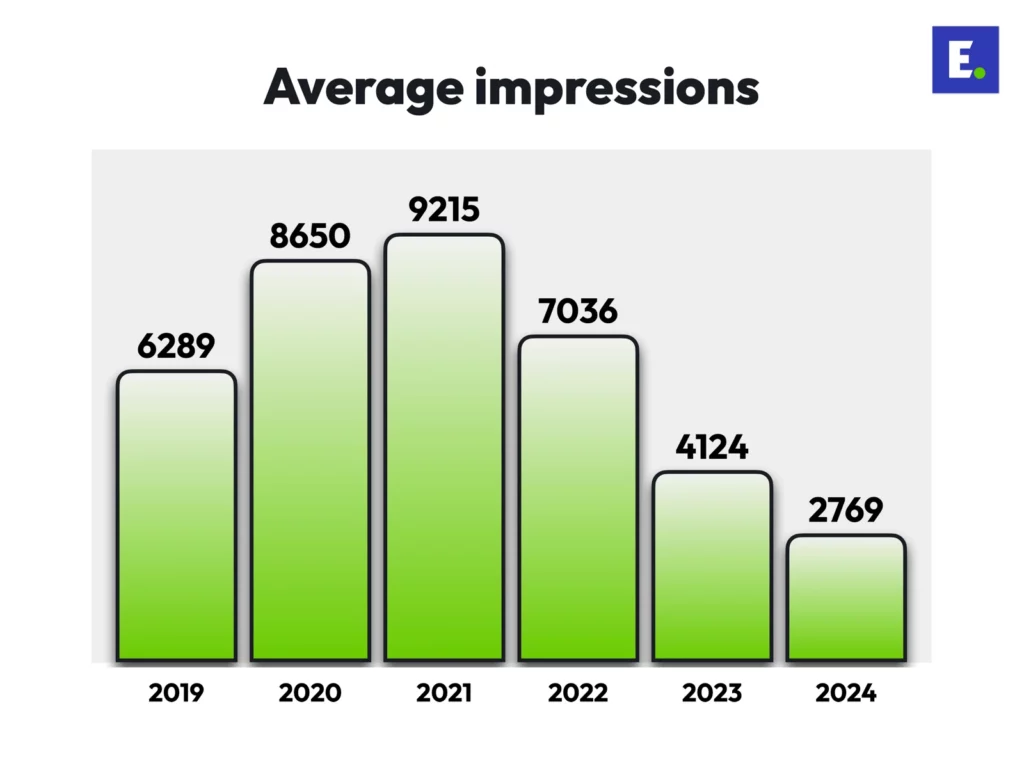Here are my LinkedIn post visibility and engagement stats for the past 5 years, to show how things have changed as the platform has grown.
I’m sharing this info so that you can see that even a regular LinkedIn content creator can experience declining visibility on the platform. I’ll remind you below of the advice I give to everyone who I help with LinkedIn best practice.
- Introduction
- Total posts
- Average impressions
- Average reactions
- Average comments
- Average reposts
- The important reminder
Introduction.
My data for this piece relates to shortform public posts I made from the start of 2019 until the end of 2024. I gathered this information using the Excel spreadsheet that I shared during my talk at the UpLift Live 24 conference.
For reference, there were around 610 million LinkedIn members at the start of 2019, and around 1.08 billion members at the end of 2024. That means the platform’s membership has grown 77% in that period.
Calculations I’ve shared in my LinkedIn membership tracker suggest that there are around 364 million active users on LinkedIn as of the end of 2024.
Total posts.
Here are the total number of posts I’ve published each year on LinkedIn. I’m counting only public, shortform posts here.

My total posts for 2024 are down on my average for the previous few years. Some of that is because I’ve been focusing more on my Espresso+ community (these figures don’t include the large number of private posts I’ve made there), but also for some other personal reasons – turns out that buying a house and supporting an ill parent takes up quite a lot of time and energy …
(For completeness, at the time of writing, I’ve published a total of 23 episodes of my relentlessly helpful® newsletter and 38 articles. These are examples of longform content, which aren’t captured by the graphs.)
Average impressions.
This is where I’ve seen the biggest proportional drop in visibility, with my 2024 average being 30% of what it was back in 2021.

The high average numbers from a few years ago were in part because so many people were online and working from home in 2021, during the height of the Covid pandemic.
Some of the reason the numbers have dropped so much now is because there are many more users on the platform (as per the introduction to this piece), leading to content creators getting a thinner slice of the visibility pie.
I have no reason to believe that my LinkedIn content is only 30% as good as it was in 2021, but circumstances dictate that fewer people are seeing my stuff.
By the way, my follower count has increased but now appears to have flatlined mostly due to a couple of major purges that LinkedIn have done over the past 18 months. Here are my figures anyway:
- Start of 2019: 5000 followers
- Start of 2020: 15,000 followers
- Start of 2021: 31,000 followers
- Start of 2022: 39,000 followers
- Start of 2023: 45,000 followers
- Start of 2024: 45,000 followers
Average reactions.
There’s been a steady decline here, too, though my peak for impressions was in 2020.
My average impressions are now around 38% of what they were at their highest.

Again, I’m not going to conclude that my content is less “like-worthy” now than it was before.
The numbers are a good reminder that the overwhelming majority of those who see your content in the LinkedIn feed won’t interact with it in any way. They might still be learning from and enjoying the content.
And crucially, they might see your content at just the right time to finally take action on something and then get in touch. You never know. So, don’t give up just because most people don’t get involved in any public engagement with your LinkedIn content. They’re still there in the shadows.
Average comments.
I’m pleased that my average comments haven’t decreased at the same rate as the other visibility metrics, as conversation really is at the heart of the success I’ve had on LinkedIn.
The killer tip here is to try to move the public conversations you have in the comments to the direct messages. That’s where the real business happens, at least for me.

My 2024 average for comments stands at 49% of the peak it reached in 2020.
I wish my stats would show me the average number of unique comments I received on my posts, but my own replies to others’ comments were part of the count.
As I try to reply to every real comment I receive, the true average numbers for the above graph should probably be roughly halved to exclude my own contributions.
Average reposts.
I don’t pay much attention to reposts (formerly known as reshares) but I’ve included the stats for this because it’s the only engagement metric to have increased over the past year.

Reposting is good for the visibility of a piece of content, but I almost never do it myself, as to me it feels and looks better to comment on the original post. If I have something important to say about a topic, I’d prefer to start my own post rather than reposting the original.
(If you’re used to Twitter/X, retweeting is far more powerful than the equivalent reposting on LinkedIn. Don’t be fooled into thinking that all social media is geared equally.)
The important reminder.
It would be easy to look at my figures and wonder whether it’s worth bothering with LinkedIn at all. While I accept that declining visibility is real for me and almost all LinkedIn users I speak with, I don’t see that as a strong reason to abandon the platform.
LinkedIn continues to be the world’s largest business-focused networking site, and you can still get access to most of the benefits of being part of it completely for free.
The absolute number of people your posts will reach might be on the wane, but if your messaging is crafted to make clear what value you bring and who you’re there to serve, it’s still possible for you to start and maintain conversations with potential customers and referral partners.
There may be other, more profitable social media avenues for you to investigate, but remember that LinkedIn has been going since 2003 and has no real competitors of its type. It’s as close to a surefire bet as anything in the online world, and it’s as likely as anywhere to be the place where you can have civilised discussions about work and business.
Think about how LinkedIn can be relevant to you and your business as we start the second quarter of this century – and drop me a line on LinkedIn if you’d like to chat about how to make LinkedIn work for you.


